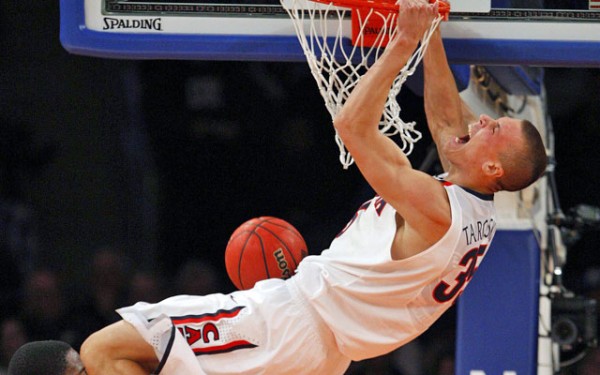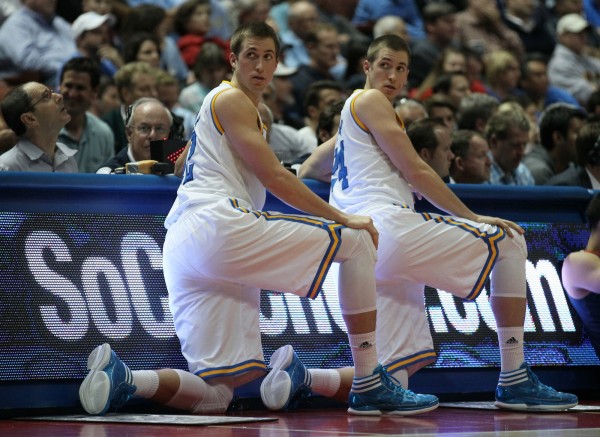Marching to Vegas: On Accusations of Softness
Posted by Adam Butler (@pachoopsab) on December 20th, 2013Adam Butler (@pachoopsab) of Pachoops again will be joining us all year, providing us with his weekly take on our favorite conference, as we begin the March to Las Vegas.
Coaches love to talk about playing hard. It’s generally not quantifiable and it sometimes doesn’t really mean much. They also evidently like to talk about their wives’ abilities, but leadership in and of itself is a fascinating topic we can cover another time. I broached the subject this week with regards to the Utah Utes and their coach, Larry Krystkowiak’s comments from earlier this season. He believed that playing hard is a talent and I wonder what playing hard really looks like? Is it something we just say to support a moral victory? Let inferior teams feel better about themselves? I didn’t like Larry’s comments but I do appreciate the sentiment. Alas, what’s sending me down the path we’re about to walk down was a comment on a different post I wrote (I swear this isn’t a bunch of plugs for Pac Hoops or Adam Butler). The premise of the comment was that Kaleb Tarczewski, Arizona’s seven-foot center, was soft. Otherwise known as the type of player who perhaps doesn’t play hard. And so full circle we come, what does it mean to play hard?
To examine this I want to use this perception that Tarczewski is soft. After all, this was not the first time I’d heard this thought. I’m also going to toss Colorado’s big Josh Scott into this glimpse of softness because I’ve heard similar about him. His nickname is Jelly. What’s more, it would seem that big men often get labeled as soft more than others. They’re the ones expected to bang in the paint and to be labeled such is to say they’re not doing their job. Are Josh Scott and Kaleb Tarczewski indeed soft? Let’s do this.
Here are two large gentlemen tasked with manning the paint for their respective teams. In Scott’s case, he’s left somewhat alone down there in the absence of Andre Roberson, whereas Tarczewski has some other solid post help; but he’s the only one among the Arizona lot that’s spending the bulk of his time down low (the others have jumpers or are Aaron Gordon). That should do for introductions of these perceived softies. Now first of all, I’d like to note that both players, as compared to their freshman campaigns, are committing fewer fouls per 40 minutes this season. I think this is an interesting statistic in that fouls can be considered an element of “hard,” but they’re also detrimental to one’s playing time. It’s a double-edged sword for bigs in that they’re soft if they don’t foul, otherwise if they don’t. Interestingly enough, both players this season have managed to improve their block percentages while lowering their number of committed fouls.
And while we’re on the subject of fouls, both players do a fantastic job of drawing fouls. Tarczewski leads the Wildcats in free throw rate (among players that qualify per KenPom and despite lowering his year-over-year rate), while Josh Scott has gone foul-drawing crazy. His free throw rate has skyrocketed to 83rd in the nation at a ridiculous 76.2 percent. That’s up from 35.7 percent a season ago. And so I ask: If someone is so soft, how is it that he’s shooting that many free throws? Between the two of them, they’re taking more then 58 percent of their shots at the rim. You go up soft around the rim and your shot is blocked or you miss it. You go hard to the basket? Well then you do what Tarczewski has done and finish at an 80 percent field goal conversion rate at the rim. Or you do what Scott has done and get to the line. Free tosses are nice particularly when you hit 82 percent of them. So sure, maybe free throws are soft considering they’re free and it’s lonely out there, but the route to get there? Not so much.
Perception doesn’t always mean reality. And frankly the converse isn’t always true, either. There still may be a soft stigma to each of their games but the numbers would begin to suggest otherwise.
But soft can be a tough one to kick; ask the continent of European basketball players. But within the scope of Pac-12 basketball and frontcourts, our own Drew Murawa, Brian Otskey and I began a conversation on The Twitter. You can read the whole thing here. The centerpiece was the Wear family, who – along with their UCLA teammates – had just lost to Duke. In the effort, between David, Travis and Tony Parker, the Bruins’ frontcourt combined to take just four free throws (all Tony) and collected 11 rebounds. As the conversation raged – or progressed, rather – I was drawn back to these stories of Tarczewski and Scott and their movement into the post and shots around the rim and their finishing or foul drawing in that area. As you look at the Duke vs. UCLA numbers, you notice that they took 22 threes or 37 percent of their offense from distance. Their norm is 27 percent. Between the aforementioned bigs, they took five shots at the rim among their 16 total shots. To an extent, they gave up on the easy shots. The saving grace – in some capacity – would be that David Wear was 4-of-4 from distance, but that’s not what he’s there for. These are the numbers that suggest soft and these are the numbers that UCLA needs reversed. For the season, David and Travis are taking a combined 48 percent of their shots at the rim with a less than 30 percent free throw rate. Attack mode could benefit their games and their roles.
But that’s the beauty of it all, the art of this game. Steve Alford’s job is to get his square pieces into round holes the same way Sean Miller, Tad Boyle, and every other coach has to do with theirs. They’ll try to get players to play hard, it just might all look a little different. For some, they might be putting themselves in better positions to be successful.












































[…] So I wrote all about it for my weekly column, Marching to Vegas, on Rush the Court. […]
[…] a 147% increase over last season’s FTRate. He’s drawing greater than 6 fouls per forty minutes. Once perceived as soft, he’s banging his way to the free throw line and offensive success. Such a post asset is going to […]
[…] a behemoth. I know because I was that kid. But I don’t want to do that because I kinda already did that. So here is the segment where I defend Steve Alford! I don’t think he needs to be defended […]